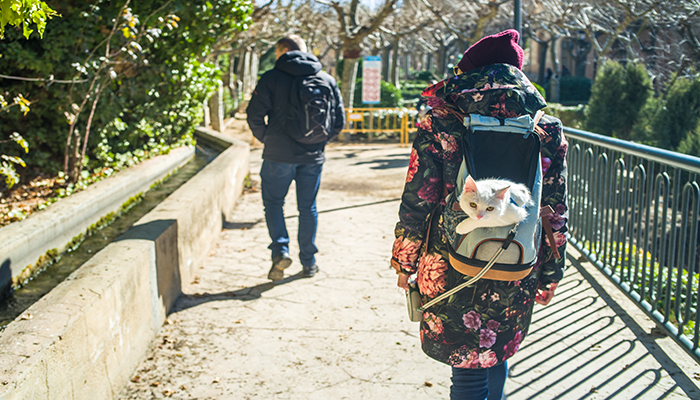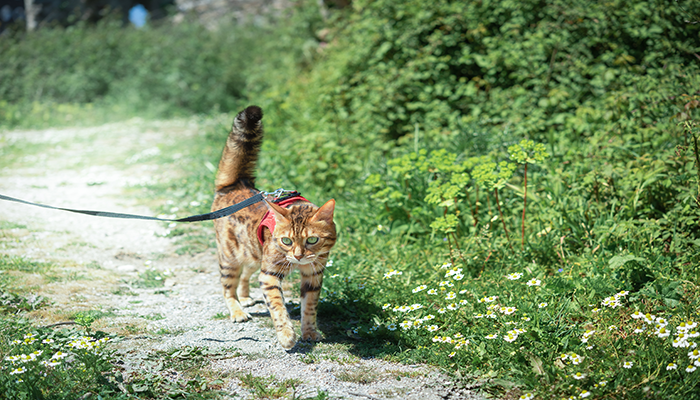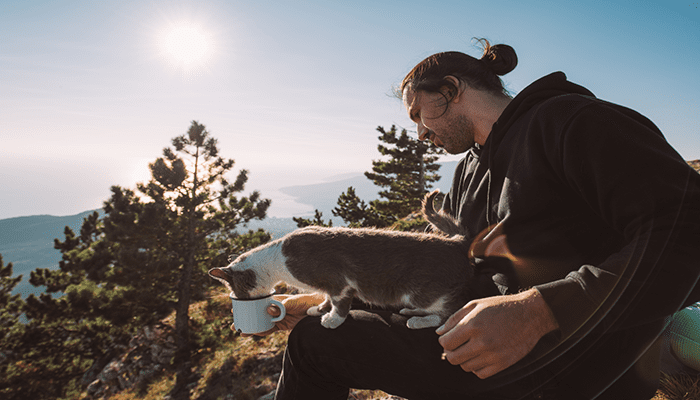Why pet owners choose Petcover for pet insurance
Why pet owners choose Petcover for flexible insurance, clear coverage, and reliable vet care.
Read more18 December 2024
Hiking is a great way to enjoy the outdoors and connect with nature. While hiking with dogs is considered the norm, why should cats miss out on the adventure? It might sound unusual, but bringing your cat along can be a fun and rewarding experience for both of you.
Before you hit the trails, you’ll need to prepare with the right equipment and make sure your cat is ready for the adventure. Here are Pet Nurture’s top tips for making sure your adventurous kitty stays safe and has a great time.
What to pack
How to prepare for your cat hike
Top tips for hiking with your cat
If you’re planning a hiking adventure with your cat, having the right gear is a must! Cats have their own unique needs, so we’ve put together a handy cat hiking packing list to make sure your furry friend stays comfy, safe, and happy on the trail.
A strong, escape-proof harness is essential for your hike, especially if your cat is the Houdini type. A good harness will keep your cat from straying, especially in case of being spooked while out walking. It’s a good idea to pack spares, just in case.
Remember to attach an ID tag with your contact information. A GPS tracker or an Apple Airtag can also be helpful if your cat manages to get loose and wander off.
Your cat’s little legs won’t be used to walking hiking distances at pace, so a cat backpack provides a safe place to rest. A lightweight sleeping bag or blanket at the bottom of the bag will keep your cat comfortable while resting.

Your first aid kit includes supplies suitable for both you and your cat, but don’t forget pet-safe wound care items. It makes sense to familiarise yourself with basic cat first aid too.
Carry a physical map in case you lose GPS signal and familiarise yourself with the route beforehand. Research and mark out pet-friendly areas, rest stops, and potential hazards on your route.
A flashlight or headlamp is important for visibility during low-light conditions. You can also attach a small light to your cat’s harness to keep them visible at night.
Pack sunscreen for yourself and make sure your cat has access to shaded areas during breaks. If your cat has light-coloured fur or exposed skin use pet-safe sunscreen to protect it.
Choose a compact, foldable litter tray and lightweight litter for ease. Wipes and garbage bags are essential, ensuring you leave no trace on the trail and take your rubbish home with you.
Carry plenty of water for you and your cat. Dehydrated cat food can save space but be sure to introduce your cat to it before the trip. Treats can be used to encourage your cat to keep moving, while collapsible bowls are lightweight and easy to use on the go.
You’ve probably got hundreds of pictures of your cat on your phone, but if not, carry a photo of your cat with you just in case they get lost. A picture can help others identify your cat if they go missing.
Pack a weatherproof cover for your cat’s backpack. Consider a small compact and breathable tarp or emergency rain shelter for quick setup during sudden storms. A cat jacket can be handy in cooler weather.
A lightweight emergency tent is essential for unexpected overnight stays. A durable ground sheet can also help create a dry resting spot.

Now that you have all the gear for your hiking adventure with your cat, it’s time to focus on the preparation for the big day. These preparations will set the foundation for a successful hiking journey with your cat.
By training your cat to be comfortable walking on a harness and leash in the backyard or outdoors, you’re empowering him to explore the world safely and controlled. Start with short walks around the block to get him used to walking alongside you.
Your cat should be able to respond to basic cues like come, sit and stay before heading out. Don’t expect every cat to follow the trail or shadow you. Read more about Pet Nurture’s tips for positive reinforcement.
Your cat should be fully vaccinated and on flea, tick, and heartworm prevention. This is not only essential for your cat’s health but also helps protect Australian wildlife by reducing the risk of your cat spreading diseases.
It’s also important to check your cat’s paws regularly to ensure they aren’t burnt, injured, or damaged.
When choosing a trail for your cat, consider their age and fitness. Older cats or those with medical conditions may struggle with long distances or rough terrain. Kittens shouldn’t hike for long, as their developing bodies are prone to injury. If your cat is only used to short walks or being carried, start off with a short walk and increase it gradually.
Many national parks, historic, indigenous or sacred sites have restrictions on pets on trails and in wilderness areas for their protection and preservation of local flora and fauna. It is recommended that you check with relevant authorities before visiting.
Before heading out with your cat, check the weather. While some cats might love a little swim, they’ll probably hate getting caught in the rain on a hike.
Warm weather can be tough on cats, so it’s important to keep them cool. Heatstroke can be fatal for cats. You can wrap some ice packs in a cloth and pop them in your backpack to help keep your cat cool.
On really hot days, it’s probably best to avoid a hike altogether, as cats with light-coloured, fine, or no fur are at a high risk of sunburn.

Stick to the marked hiking trails—it’s the best way to avoid getting lost and to protect the environment. Plus, it helps keep the natural beauty of the area intact for everyone to enjoy.
You’re not the only one who needs to rest—your cat does too! Find a comfy spot where you can both rest, grab a snack, drink some water, and recharge.
When you’re exploring the great outdoors with your cat, keep an eye out for things like pesky plants or run-ins with wildlife. If you spot a snake or anything that seems risky, scoop up your cat to keep them safe.
Pay attention to how your cat’s feeling too—signs like excessive meowing, panting, or hiding can mean they’re stressed.
As you gear up for your wilderness adventure, don’t forget one final but crucial step—make sure you’re cat has pet insurance in place. Accidents can happen, especially in rugged environments, and having a good policy means you’re prepared for the unexpected. Stay safe, and happy exploring!
Get a cat insurance quote